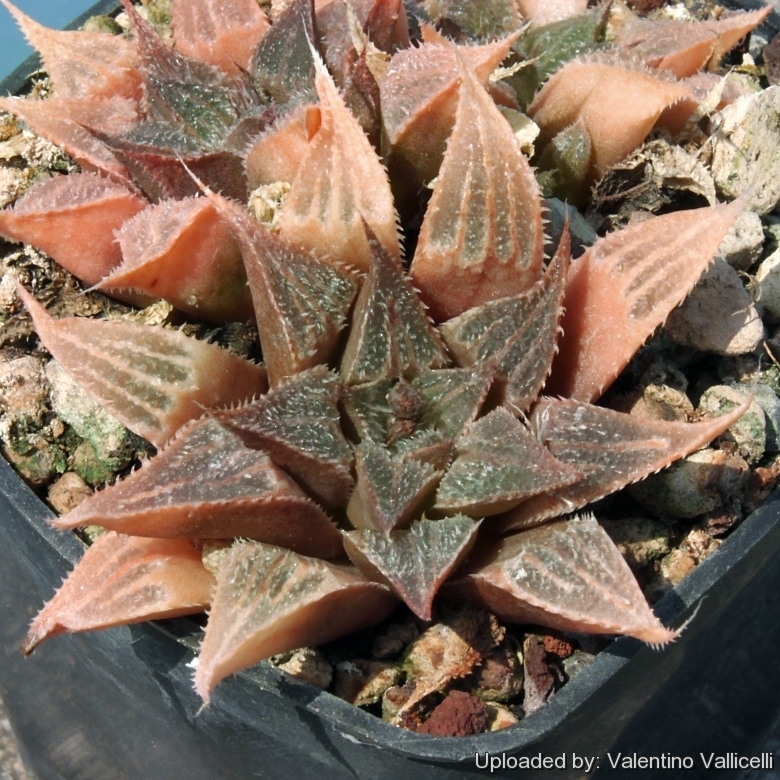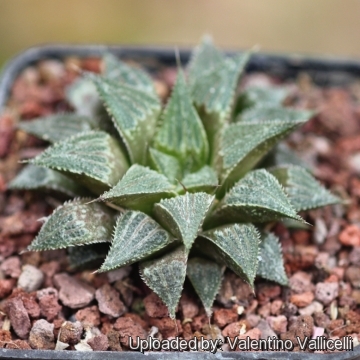
Haworthia emelyae var. major Photo by: Valentino Vallicelli
Origin and Habitat: Western Cape, Southern Little Karoo, South Africa. Haworthia emelyae var. majorSN|13361]]SN|13353]] is linked to Haworthia emelyaeSN|13363]]SN|13363]] toward the east and north of the areal as well as to Haworthia emelyae var. multifoliaSN|13353]]SN|13361]] to the west.
Synonyms:
See all synonyms of Haworthia emelyae
Description: Haworthia emelyae var. majorSN|13363]]SN|13353]] is a small dark-bodied plant with textured leaf surface and lovely symmetry.
Distinctive characteristic: The var. major has an unusually large flower similar to that of Haworthia emelyaeSN|13353]]SN|13363]] and there is evidence of intergradation of these two taxa. Although in this variety the leaf tubercles are armed with a spine, the general form of the plants is that of H. emelyae.
Rosettes: Stemless, usually solitary that rarely offsets and only grows to about 8cm across.
Leaves: Dark, rough-surfaced (almost like sandpaper) with a triangular flat topped, translucent area, with small white, spiny, crystalline tubercules that converge into lines running to the point. The leaves turn almost red in winter.
Inflorescence: 30 cm tall.
Flowers: White with green veins.
Remarks: This a favorite plant for hybridizers and there are a few outstanding hybrids using this as one of the parents.
Bibliography: Major references and further lectures
1) Urs Eggli “Illustrated Handbook of Succulent Plants: Monocotyledons” Springer, 01/gen/2001
2) M. B. Bayer “The new Haworthia handbook” National Botanic Gardens of South Africa, 1982
3) John Pilbeam “Haworthia and Astroloba: A Collector's Guide” 1983
4) Stuart Max Walters, James Cullen “The European Garden Flora: Pteridophyta, Gymnospermae, Angiospermae” Cambridge University Press, 1986
5) John Robert Brown "Unusual Plants:110 Spectacular Photographs of Succulents" Abbey Garden Press, 1954
6) Doreen Court “Succulent Flora of Southern Africa” Struik Nature, 2010
7) Bayer, MB “Haworthia Revisited: A revision of the genus” Umdaus Press, Hatfield. 1999
8) Hilton-Taylor, C.. “Red data list of southern African plants.” Strelitzia 4. South African National Botanical Institute, Pretoria. 1996
9) Bruce Bayer "Haworthia emelyae ‘major’ and multifolia. New populations." Volume 6, Chapter 5. http://haworthiaupdates.org/category/emelyae/
 Haworthia emelyae var. major Photo by: Valentino Vallicelli
Haworthia emelyae var. major Photo by: Valentino VallicelliSend a photo of this plant.The gallery now contains thousands of pictures, however it is possible to do even more. We are, of course, seeking photos of species not yet shown in the gallery but not only that, we are also looking for better pictures than those already present.
Read More... Cultivation and Propagation: Haworthia are of easy cultivation and relatively low maintenance, which makes them a good houseplant, and can be an excellent subject for the beginning succulentophile (they can grow easily on window sills, verandas and in miniature succulent gardens where they are happy to share their habitat with other smaller succulent plants, or in outdoor rockeries).
Growth rate: They are relatively slow-growing plants that offsets freely to form small clusters.
Soil: They are tolerant of a wide range of soils and habitats, but prefer a very porous potting mix to increase drainage. A non-acid soil is ideal. You can grow a plant in a 10-15 cm pot for years and have perfectly happy plants. Needs a deep pot to accommodate the long, thick, contractile roots.
Fertilization: The plants are fertilized only once during the growing season with a balanced fertilizer diluted to ½ the recommended strength.
Watering: It needs regular water, but do not water again until dry. Also, it is a species that is dormant in the winter and requires very little water (maybe even none) during the cold months.
Frost Tolerance: Light frost protection required. Minimum of 5ºC for safe growing (but hardy up to -5°C or less.)
Sun Exposure: Requires light shade to bright light (protect from strong midday sun). In shade the body colour will remain mostly green, while full sun will darken and give it a rich pink-red body colour. Can be sunburned if moved from shade/greenhouse into full sun too quickly. The amount of sunlight it can withstand without scorching depends upon the how hot it becomes in the summer in the location in which it is planted. It will have more colour if it receives more light. During the spring it may be able to take full sun until the heat arrives at the end of spring. In an area that has hot afternoon sun, it may be able to take full morning sun, but requires afternoon shade or afternoon light shade.
Remarks: Haworthias are best planted in a shaded and airy part of the greenhouse, and not too close to the glass roof or sides of the house as the plants can overheat during hot spells.
Rot: Rot is only a minor problem with Haworthia if the plants are watered and “aired” correctly. If they are not, fungicides won't help all that much. Care must be given in watering, keeping them warm and wet while growing, and cooler and dry when dormant.
Propagation: Offsets that appear at the base between the leaves; leave them attached to form a cluster, or wait until they are 1/3 the size of the parent and then detach and plant.











